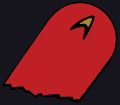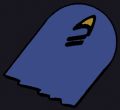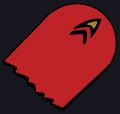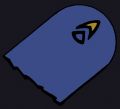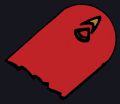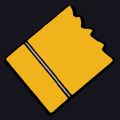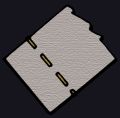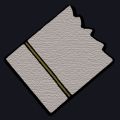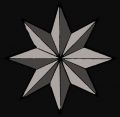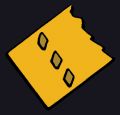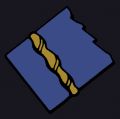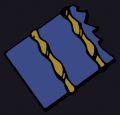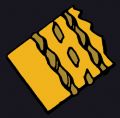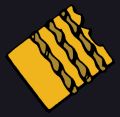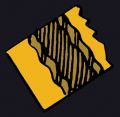Difference between revisions of "Starfleet Ranks"
m |
m |
||
| Line 1: | Line 1: | ||
| − | == | + | ==Enlisted== |
| + | In the mid-23rd century, assignment insignia was located on both sleeves, 3cm below the shoulder seam. Rank stripes and insignia were black, and were 0.5cm wide. The distance between assignment and rank insignia was 3cm.<ref name="FASA2001A"/> | ||
| − | == | + | ===Recruit=== |
| + | Recruits could enter [[Starfleet]] at the age of 18 (or age 17 if their first assignment was to a colony world or other non-ship posting). Recruits underwent extensive training and orientation in Star Fleet and [[United Federation of Planets]] life for 18 months at induction centers located on various worlds. They would then receive six months of specialized training appropriate to each individual's potential and cultural background. In the early 2300s, the insignia for a Recruit was a plain, one-piece white uniform design with no decoration except for a standard [[combadge|communicator]].<ref name="FASA2012"/> | ||
| + | <gallery> | ||
| + | File:starfleet_ranks_e1-fasa2001a.jpg|200px|thumb|left|Recruit (c.2260) ([[Star Trek: The Role Playing Game (FASA-2001)|FASA2001A]]) | ||
| + | </gallery> | ||
| − | == | + | ===Specialist 2nd Class=== |
| + | Second Class Specialists, known as Enlisted Second Class in the mid-23rd century,<ref name="FASA2001A"/> were individuals who had demonstrated leadership and technical competence in a given area of operations. "Spec Twos" could command four to ten junior Specialists, depending on individual duty assignments. In the mid-24th century, the insignia for Specialist Second Class was one hollow brass diamond worn on each uniform wrist cuff.<ref name="FASA2012"/><ref group="Notes" name="PO1"/> | ||
| + | <gallery> | ||
| + | File:starfleet_ranks_e2-fasa2001a.jpg|200px|thumb|left|Enlisted 2nd Class (c.2260) ([[Star Trek: The Role Playing Game (FASA-2001)|FASA2001A]]) | ||
| + | File:starfleet_ranks_e2-fasa2012.jpg|200px|thumb|left|Specialist 2nd Class (c.2350) ([[Star Trek: The Next Generation Officer's Manual (FASA-2012)|FASA2012]]) | ||
| + | </gallery> | ||
| − | == | + | ===Specialist 1st Class=== |
| + | Specialist First Class, known as Enlisted First Class in the early 2200s,<ref name="FASA2001A"/> were enlisted personnel whose competence and leadership were sufficient to permit them independent control of junior Specialists without direct supervision by officers. In the mid-24th century, the insignia for Specialist First Class was one solid brass diamond worn on each uniform wrist cuff.<ref name="FASA2012"/><ref group="Notes" name="PO1"/> | ||
| + | <gallery> | ||
| + | File:starfleet_ranks_e3-fasa2001a.jpg|200px|thumb|left|Enlisted 1st Class (c.2260) ([[Star Trek: The Role Playing Game (FASA-2001)|FASA2001A]]) | ||
| + | File:starfleet_ranks_e3-fasa2012.jpg|200px|thumb|left|Specialist 1st Class (c.2350) ([[Star Trek: The Next Generation Officer's Manual (FASA-2012)|FASA2012]]) | ||
| + | </gallery> | ||
| − | == | + | ===Chief Specialist=== |
| + | Chief Specialists, known as Petty Officer Second Class in the mid-23rd century,<ref name="FASA2001A"/> had advanced technical and administrative skills and could command large groups of enlisted personnel without officers' supervision for extended periods of time. In the mid-24th century, the insignia for Chief Specialist was one hollow and one solid brass diamond worn on each uniform wrist cuff.<ref name="FASA2012"/><ref group="Notes" name="PO1"/> | ||
| + | <gallery> | ||
| + | File:starfleet_ranks_e4-fasa2001a.jpg|200px|thumb|left|Petty Officer 2nd Class (c.2260) ([[Star Trek: The Role Playing Game (FASA-2001)|FASA2001A]]) | ||
| + | File:starfleet_ranks_e4-fasa2012.jpg|200px|thumb|left|Chief Specialist (c.2350) ([[Star Trek: The Next Generation Officer's Manual (FASA-2012)|FASA2012]]) | ||
| + | </gallery> | ||
| − | == | + | ===Petty Officer=== |
| + | The rank of Petty Officer, known as Petty Officer First Class in the mid-23rd century,<ref name="FASA2001A"/> was given to non-commissioned officers who had shown exceptional leadership in their own areas. A Petty Officer typically commanded a group of enlisted personnel, often independent of direct supervision by junior officer grades.<ref name="FASA2012"/> In the mid-24th century, the insignia for Petty Officer was one hollow brass circle worn on the right uniform lapel.<ref group="Notes" name="PO1"/> | ||
| + | <gallery> | ||
| + | File:starfleet_ranks_e5-fasa2001a.jpg|200px|thumb|left|Petty Officer 1st Class (c.2260) ([[Star Trek: The Role Playing Game (FASA-2001)|FASA2001A]]) | ||
| + | File:starfleet_ranks_e5-fasa2012.jpg|200px|thumb|left|Petty Officer (c.2350) ([[Star Trek: The Next Generation Officer's Manual (FASA-2012)|FASA2012]]) | ||
| + | </gallery> | ||
| − | ==Fleet Captain== | + | ===Chief Petty Officer=== |
| + | The rank of Chief Petty Officer was given to non-commissioned officers who had shown exceptional leadership in their own areas. A Chief Petty Officer typically commanded a group of enlisted personnel, often independent of direct supervision by junior officer grades. In the mid-24th century, the insignia for Chief Petty Officer was one hollow gold circle worn on the right uniform lapel.<ref name="FASA2012"/><ref group="Notes" name="PO1"/> | ||
| + | <gallery> | ||
| + | File:starfleet_ranks_e6-fasa2001a.jpg|200px|thumb|left|Chief Petty Officer (c.2260) ([[Star Trek: The Role Playing Game (FASA-2001)|FASA2001A]]) | ||
| + | File:starfleet_ranks_e6-fasa2012.jpg|200px|thumb|left|Chief Petty Officer (c.2350) ([[Star Trek: The Next Generation Officer's Manual (FASA-2012)|FASA2012]]) | ||
| + | </gallery> | ||
| + | |||
| + | ===Senior Chief Petty Officer=== | ||
| + | The rank of Senior Chief Petty Officer was given to non-commissioned officers who had shown exceptional leadership in their own areas. A Senior Chief Petty Officer typically commanded a group of enlisted personnel, often independent of direct supervision by junior officer grades. In the mid-24th century, the insignia for Senior Chief Petty Officer was two hollow gold circles worn on the right uniform lapel.<ref name="FASA2012"/><ref group="Notes" name="PO1"/> | ||
| + | <gallery> | ||
| + | File:starfleet_ranks_e7-fasa2001a.jpg|200px|thumb|left|Senior Chief Petty Officer (c.2260) ([[Star Trek: The Role Playing Game (FASA-2001)|FASA2001A]]) | ||
| + | File:starfleet_ranks_e7-fasa2012.jpg|200px|thumb|left|Senior Chief Petty Officer (c.2350) ([[Star Trek: The Next Generation Officer's Manual (FASA-2012)|FASA2012]]) | ||
| + | </gallery> | ||
| + | |||
| + | ===Master Chief Petty Officer=== | ||
| + | The rank of Master Chief Petty Officer was given to non-commissioned officers who had shown exceptional leadership in their own areas. A Master Chief Petty Officer typically commanded a group of enlisted personnel, often independent of direct supervision by junior officer grades. In the mid-24th century, the insignia for Master Chief Petty Officer was three hollow gold circles worn on the right uniform lapel.<ref name="FASA2012"/><ref group="Notes" name="PO1"/> | ||
| + | <gallery> | ||
| + | File:starfleet_ranks_e8-fasa2001a.jpg|200px|thumb|left|Master Chief Petty Officer (c.2260) ([[Star Trek: The Role Playing Game (FASA-2001)|FASA2001A]]) | ||
| + | File:starfleet_ranks_e8-fasa2012.jpg|200px|thumb|left|Master Chief Petty Officer (c.2350) ([[Star Trek: The Next Generation Officer's Manual (FASA-2012)|FASA2012]]) | ||
| + | </gallery> | ||
| + | |||
| + | <div style="clear:both;"> </div> | ||
| + | ==Warrant Officers== | ||
| + | Non-commissioned officers who had displayed exceptional expertise in technical or mechanical areas were awarded this rank. Warrant Officers typically commanded a group of enlisted personnel who acted as technical assistants answerable only to the Warrant Officer.<ref name="FASA2012"/> In the mid-23rd century, stripes were 1cm wide, silver, and located 6cm from the cuff.<ref name="FASA2001A"/> In mid-24th century, Warrant Officers wore one, two, or three gold rectangles on the right uniform collar to indicate Warrant Officer, Chief Warrant Officer,<ref group="Notes" name="CWO"/> or Master Warrant Officer.<ref name="FASA2012"/> | ||
| + | |||
| + | <gallery> | ||
| + | File:starfleet_ranks_wo1-fasa2001a.jpg|200px|thumb|left|Warrant Officer (c.2260) ([[Star Trek: The Role Playing Game (FASA-2001)|FASA2001A]]) | ||
| + | File:starfleet_ranks_wo2-fasa2001a.jpg|200px|thumb|left|Chief Warrant Officer (c.2260) ([[Star Trek: The Role Playing Game (FASA-2001)|FASA2001A]]) | ||
| + | File:starfleet_ranks_wo1-fasa2012.jpg|200px|thumb|left|Warrant Officer (c.2350) ([[Star Trek: The Next Generation Officer's Manual (FASA-2012)|FASA2012]]) | ||
| + | File:starfleet_ranks_wo2-fasa2012.jpg|200px|thumb|left|Chief Warrant Officer (c.2350) ([[Star Trek: The Next Generation Officer's Manual (FASA-2012)|FASA2012]]) | ||
| + | File:starfleet_ranks_wo3-fasa2012.jpg|200px|thumb|left|Master Warrant Officer (c.2350) ([[Star Trek: The Next Generation Officer's Manual (FASA-2012)|FASA2012]]) | ||
| + | </gallery> | ||
| + | |||
| + | <div style="clear:both;"> </div> | ||
| + | ==Cadets== | ||
| + | In the mid-23rd century, stripes were 1cm wide, gold, and located 6cm from the cuff.<ref name="FASA2001A"/> | ||
| + | |||
| + | ===Cadet=== | ||
| + | <gallery> | ||
| + | File:starfleet_ranks_c1-fasa2001a.jpg|200px|thumb|left|Cadet (c.2260) ([[Star Trek: The Role Playing Game (FASA-2001)|FASA2001A]]) | ||
| + | </gallery> | ||
| + | |||
| + | ===Midshipman=== | ||
| + | Midshipmen were recent graduates of [[Starfleet Academy]] who had completed their final cadet cruises. These officers were typically assigned duties as junior aides to line officers in either the technical or scientific branches of [[Starfleet]]. Midshipmen might also have been assistants to officers in foreign legions and administrative officers. Such assignments were typically between six and eighteen months in duration, after which promotion was routine.<ref name="FASA2012"/> | ||
| + | <gallery> | ||
| + | File:starfleet_ranks_c2-fasa2001a.jpg|200px|thumb|left|Midshipman (c.2260) ([[Star Trek: The Role Playing Game (FASA-2001)|FASA2001A]]) | ||
| + | File:starfleet_ranks_c2-fasa2012.jpg|200px|thumb|left|Midshipman (c.2350) ([[Star Trek: The Next Generation Officer's Manual (FASA-2012)|FASA2012]]) | ||
| + | </gallery> | ||
| + | |||
| + | <div style="clear:both;"> </div> | ||
| + | ==Officers== | ||
| + | In the mid-23rd century, stripes were 2cm wide, gold, and located 6cm from the cuff.<ref name="FASA2001A"/> | ||
| + | |||
| + | ===Ensign=== | ||
| + | Ensigns served as junior officers in a variety of duty stations both aboard ship and at starbases and ground installations.<ref name="FASA2012"/> | ||
| + | |||
| + | Junior Grade Ensigns, introduced in the mid-24th century, were typically recent graduates of [[Starfleet Academy]], and served as technical and administrative assistants. In rare cases, a civilian could receive the honorary rank of Ensign Junior Grade to coordinate enlisted personnel aboard ship for a limited duration.<ref name="FASA2012"/> | ||
| + | <gallery> | ||
| + | File:starfleet_ranks_o1-fasa2001a.jpg|200px|thumb|left|Ensign (c.2260) ([[Star Trek: The Role Playing Game (FASA-2001)|FASA2001A]]) | ||
| + | File:starfleet_ranks_o0-fasa2012.jpg|200px|thumb|left|Ensign, junior grade (c.2350) ([[Star Trek: The Next Generation Officer's Manual (FASA-2012)|FASA2012]]) | ||
| + | File:starfleet_ranks_o1-fasa2012.jpg|200px|thumb|left|Ensign (c.2350) ([[Star Trek: The Next Generation Officer's Manual (FASA-2012)|FASA2012]]) | ||
| + | </gallery> | ||
| + | |||
| + | ===Lieutenant, junior grade=== | ||
| + | Junior grade Lieutenants aboard ship were responsible for the direct operation of non-bridge duty stations under the supervision of senior personnel. Bridge operations involving navigation and helm control were also assigned to junior grade Lieutenants under the supervision of senior officers. At ground installations, junior grade Lieutenants typically acted as station-keepers under the direction of a senior Lieutenant.<ref name="FASA2012"/> | ||
| + | <gallery> | ||
| + | File:starfleet_ranks_o2-fasa2001a.jpg|200px|thumb|left|Lieutenant, junior grade (c.2260) ([[Star Trek: The Role Playing Game (FASA-2001)|FASA2001A]]) | ||
| + | File:starfleet_ranks_o2-fasa2012.jpg|200px|thumb|left|Lieutenant, junior grade (c.2350) ([[Star Trek: The Next Generation Officer's Manual (FASA-2012)|FASA2012]]) | ||
| + | </gallery> | ||
| + | |||
| + | ===Lieutenant=== | ||
| + | Lieutenants served on Bridge command crews and as specialists aboard ships. In the absence of senior officers, Lieutenants also commanded special away teams off ship. Away from the Bridge, Lieutenants served as department heads. At starbases and ground installations, Lieutenants were in charge of specific duty stations, generally supervising from three to twelve junior officers and enlisted personnel.<ref name="FASA2012"/> | ||
| + | <gallery> | ||
| + | File:starfleet_ranks_o3-fasa2001a.jpg|200px|thumb|left|Lieutenant (c.2260) ([[Star Trek: The Role Playing Game (FASA-2001)|FASA2001A]]) | ||
| + | File:starfleet_ranks_o3-fasa2012.jpg|200px|thumb|left|Lieutenant (c.2350) ([[Star Trek: The Next Generation Officer's Manual (FASA-2012)|FASA2012]]) | ||
| + | </gallery> | ||
| + | |||
| + | ===Lieutenant Commander=== | ||
| + | Officers of Lieutenant Commander rank functioned as assistant department heads or specialists. Senior Bridge officers in charge of specific watch commands were usually Lieutenant Commanders. In vessels of Class V or below, a Lieutenant Commander was frequently assigned as first officer to a ship's captain of Commander rank. Staff officers of Lieutenant Commander rank served as aides to senior officers and could, on occasion, represent their superiors on special assignments away from normal duty stations.<ref name="FASA2012"/> | ||
| + | <gallery> | ||
| + | File:starfleet_ranks_o4-fasa2001a.jpg|200px|thumb|left|Lieutenant Commander (c.2260) ([[Star Trek: The Role Playing Game (FASA-2001)|FASA2001A]]) | ||
| + | File:starfleet_ranks_o4-fasa2012.jpg|200px|thumb|left|Lieutenant Commander (c.2350) ([[Star Trek: The Next Generation Officer's Manual (FASA-2012)|FASA2012]]) | ||
| + | </gallery> | ||
| + | |||
| + | ===Commander=== | ||
| + | Commanders generally headed up a department aboard ship. A senior flag Commander could have a specialized position, such as first officer or science officer. Commanders also served as ship's captain on vessels below Class V, receiving the technical distinction of Brevet Captain, which bestowed a captain's authority only aboard ship. Staff officers holding Commander rank typically served as aides to senior officers or as special duty personnel for inspection of civilian installations, liaison with native life forms, or provided administrative support.<ref name="FASA2012"/> | ||
| + | <gallery> | ||
| + | File:starfleet_ranks_o5-fasa2001a.jpg|200px|thumb|left|Commander (c.2260) ([[Star Trek: The Role Playing Game (FASA-2001)|FASA2001A]]) | ||
| + | File:starfleet_ranks_o5-fasa2012.jpg|200px|thumb|left|Commander (c.2350) ([[Star Trek: The Next Generation Officer's Manual (FASA-2012)|FASA2012]]) | ||
| + | </gallery> | ||
| + | |||
| + | ===Captain=== | ||
| + | Captains commanded [[Starfleet]] vessels above Class V. Captains also directed the day-to-day operational deployment and tactical command of support craft, often without the direct influence of senior commanders. Officers with technical skills in areas such as engineering, science, medicine, or security could also receive Captain's rank and usually served aboard larger vessels. Staff officers of Captain rank typically served in deputy positions on starbases or similar ground assignments, as aides to flag officers or technical advisors to senior Federation personnel.<ref name="FASA2012"/> | ||
| + | <gallery> | ||
| + | File:starfleet_ranks_o6-fasa2001a.jpg|200px|thumb|left|Captain (c.2260) ([[Star Trek: The Role Playing Game (FASA-2001)|FASA2001A]]) | ||
| + | File:starfleet_ranks_o6-fasa2012.jpg|200px|thumb|left|Captain (c.2350) ([[Star Trek: The Next Generation Officer's Manual (FASA-2012)|FASA2012]]) | ||
| + | </gallery> | ||
| + | |||
| + | ===Fleet Captain=== | ||
| + | The position of Fleet Captain is that of a senior officer who has demonstrated exceptional competence and expertise in active service. Fleet Captains were responsible for the overall deployment of specific classes of vessels throughout the fleet; in that capacity, they oversaw the construction, refitting, upgrading, and operational use of a particular vessel design, rather than taking command over individual vessels. In 2363, there were three Fleet Captains; one was responsible for [[Excelsior class|''Excelsior'']] and [[Alaska class|''Alaska'' class]] heavy vessels, the second was in charge of heavy cruiser class designs, and the third oversaw the deployment of [[Galaxy class|''Galaxy'' class]] and other long-range ships.<ref name="FASA2012"/> | ||
| + | <gallery> | ||
| + | File:starfleet_ranks_o7b-fasa2012.jpg|200px|thumb|left|Fleet Captain (c.2350) ([[Star Trek: The Next Generation Officer's Manual (FASA-2012)|FASA2012]]) | ||
| + | </gallery> | ||
| − | |||
===Commodore=== | ===Commodore=== | ||
| + | Flag officers had generally served in a variety of vital areas, including Exploration, Military Operations, and Fleet Command. Flag officers of Commodore rank commanded Tactical Operations Groups of three to six vessels. A Commodore could also serve as a starbase commander or fleet inspector, reporting to a Rear Admiral.<ref name="FASA2012"/> | ||
| + | <gallery> | ||
| + | File:starfleet_ranks_o7-fasa2001a.jpg|200px|thumb|left|Commodore (c.2260) ([[Star Trek: The Role Playing Game (FASA-2001)|FASA2001A]]) | ||
| + | File:starfleet_ranks_o7a-fasa2012.jpg|200px|thumb|left|Commodore (c.2350) ([[Star Trek: The Next Generation Officer's Manual (FASA-2012)|FASA2012]]) | ||
| + | </gallery> | ||
| + | |||
| + | ===Branch Admiral=== | ||
| + | To give greater authority to the most qualified officers in specialized branches of operation, in the mid-24th century [[Starfleet]] revamped its ranking system, extending Admiral's rank and privileges to such positions as Starfleet Surgeon General. The change gave these offices greater control over the implementation of their policies throughout the fleet. Admiral designations were established for Medical, Security, and Engineering branches. In addition, the Starfleet Inspector General's office promoted some individuals to Branch Admiral to facilitate the inspection of vessels and ground installations throughout the [[United Federation of Planets|Federation]]. The insignia for Branch Admiral was a color-coded triangle with the apex facing inward, set on a white shoulder board surrounded by silver oak leaves. Triangle colors reflected branch designations; silver for the Inspector General's office, green for Medical Corps, gold for Security, and red for Engineering.<ref name="FASA2012"/> | ||
| + | |||
| + | <gallery> | ||
| + | File:starfleet_ranks_o8b_ig-FASA2012.jpg|200px|thumb|left|Branch Admiral (Inspector General) (c.2350) ([[Star Trek: The Next Generation Officer's Manual (FASA-2012)|FASA2012]]) | ||
| + | File:starfleet_ranks_o8b_medical-FASA2012.jpg|200px|thumb|left|Branch Admiral (Medical Corps) (c.2350) ([[Star Trek: The Next Generation Officer's Manual (FASA-2012)|FASA2012]]) | ||
| + | File:starfleet_ranks_o8b_security-FASA2012.jpg|200px|thumb|left|Branch Admiral (Security) (c.2350) ([[Star Trek: The Next Generation Officer's Manual (FASA-2012)|FASA2012]]) | ||
| + | File:starfleet_ranks_o8b_eng-FASA2012.jpg|200px|thumb|left|Branch Admiral (Engineering) (c.2350) ([[Star Trek: The Next Generation Officer's Manual (FASA-2012)|FASA2012]]) | ||
| + | </gallery> | ||
| + | |||
===Rear Admiral=== | ===Rear Admiral=== | ||
| − | = | + | The rank of Rear Admiral was similar to that of other senior admirals, but Rear Admirals differed from their superiors in that their positions usually carried a specific geographical area of responsibility, such as a quadrant or sector within [[United Federation of Planets|Federation]] space. Rear Admirals also commanded Task Force Groups of eight to twelve vessels, as well as important ground installations or vessels that fell within their specific area of jurisdiction. Rear Admirals could also command [[Starfleet]] ship construction and production facilities or science and weapons labs, primary base security, security for Federation officials, procurement, and scientific analysis (particularly in sensitive areas such as intelligence gathering or clandestine operations).<ref name="FASA2012"/> |
| + | |||
| + | <gallery> | ||
| + | File:starfleet_ranks_o8a-FASA2012.jpg|200px|thumb|left|Rear Admiral (c.2350) ([[Star Trek: The Next Generation Officer's Manual (FASA-2012)|FASA2012]]) | ||
| + | </gallery> | ||
| + | |||
===Admiral=== | ===Admiral=== | ||
| + | The rank of Admiral was the highest in [[Starfleet]]. Admirals were responsible for the deployment of Starfleet vessels in active operations, particularly fleet operations along the border zones between the [[United Federation of Planets|Federation]] and foreign governments. Admirals were also responsible for exploration and training craft, as well as Federation colonization efforts. Staff positions encompassed a variety of roles, ranging from diplomatic and scientific to traditional planning and organizational tasks within Starfleet. Separate Admiralty Commands included directorship of Starfleet training operations, diplomatic liaisons with Federation member worlds, and negotiations with newly-discovered worlds. They also included a host of military positions: contingency strategy, weapons research and development, and scientific systems deployment aboard Starfleet vessels.<ref name="FASA2012"/> | ||
| + | <gallery> | ||
| + | File:starfleet_ranks_o8-fasa2001a.jpg|200px|thumb|left|Admiral (c.2260) ([[Star Trek: The Role Playing Game (FASA-2001)|FASA2001A]]) | ||
| + | File:starfleet_ranks_o8c-FASA2012.jpg|200px|thumb|left|Admiral (c.2350) ([[Star Trek: The Next Generation Officer's Manual (FASA-2012)|FASA2012]]) | ||
| + | </gallery> | ||
| + | |||
| + | {|style="width:100%;" | ||
| + | |+class="HeaderRow"|Notes | ||
| + | |- | ||
| + | |<references group="Notes"> | ||
| + | <ref name="PO1">"[[Star Trek: The Next Generation Officer's Manual (FASA-2012)|''Star Trek: The Next Generation'' Officer's Manual]]" describes the rank insignia for for Petty Officer, Petty Officer First Class, and Chief Petty Officer being one through three hollow gold circles, respectively. This has been modified to better correspond with the ranks of Petty Officer, Chief Petty Officer, Senior Chief Petty Officer, and Master Chief Petty Officer. Although outside the scope of this entry, this also explains Chief Petty Officer Miles O'Brien wearing a single hollow rank pip in later seasons of ''[[Star Trek: The Next Generation]].'' Further, the rank of Specialist has been eliminated, which also lines the 24th century enlisted rank structure more closely to that of the 23rd century Star Fleet.</ref> | ||
| + | <ref name="CWO">"[[Star Trek: The Next Generation Officer's Manual (FASA-2012)|''Star Trek: The Next Generation'' Officer's Manual]]" listed Warrant Officer ranks as Warrant Officer, Warrant Officer First Class, and Master Warrant Officer. Warrant Officer First Class has been renamed to Chief Warrant Officer for continuity purposes.</ref> | ||
| + | </references> | ||
| + | |} | ||
| − | {| | + | {|style="width:100%;" |
| − | + | |+class="HeaderRow"|References | |
|- | |- | ||
|<references> | |<references> | ||
| − | <ref name=" | + | <ref name="FASA2001A">[[McLimore, Guy W. Jr.]], [[Poehlein, Greg K.]], and [[Tepool, David F.]] "[[Core Game Book (FASA-2001A)|Core Game Book]]." ''[[Star Trek: The Role Playing Game (FASA)|Star Trek: The Role Playing Game]],'' Book 2001A. [[FASA Corporation]], 1983.</ref> |
| + | <ref name="FASA2012">[[Stuart, Rick]] and [[Terra, John]]. "[[Star Trek: The Next Generation Officer's Manual (FASA-2012)|''Star Trek: The Next Generation'' Officer's Manual]]." ''[[Star Trek: The Role Playing Game (FASA)|Star Trek: The Role Playing Game]],'' Supplement 2012. [[FASA Corporation]], 1988.</ref> | ||
</references> | </references> | ||
|} | |} | ||
| Line 30: | Line 192: | ||
[[Category:Politics]] | [[Category:Politics]] | ||
[[Category:Starfleet]] | [[Category:Starfleet]] | ||
| + | [[Category:Film]] | ||
| + | [[Category:TOS]] | ||
| + | [[Category:TNG]] | ||
| + | [[Category:DS9]] | ||
| + | [[Category:VOY]] | ||
| + | [[Category:DSC]] | ||
| + | [[Category:Books]] | ||
| + | [[Category:EXC]] | ||
| + | [[Category:NF]] | ||
| + | [[Category:Comics]] | ||
| + | [[Category:Game]] | ||
| + | [[Category:LUG]] | ||
| + | [[Category:Decipher]] | ||
| + | [[Category:Modiphius]] | ||
Revision as of 20:33, 8 February 2019
Enlisted
In the mid-23rd century, assignment insignia was located on both sleeves, 3cm below the shoulder seam. Rank stripes and insignia were black, and were 0.5cm wide. The distance between assignment and rank insignia was 3cm.[1]
Recruit
Recruits could enter Starfleet at the age of 18 (or age 17 if their first assignment was to a colony world or other non-ship posting). Recruits underwent extensive training and orientation in Star Fleet and United Federation of Planets life for 18 months at induction centers located on various worlds. They would then receive six months of specialized training appropriate to each individual's potential and cultural background. In the early 2300s, the insignia for a Recruit was a plain, one-piece white uniform design with no decoration except for a standard communicator.[2]
Recruit (c.2260) (FASA2001A)
Specialist 2nd Class
Second Class Specialists, known as Enlisted Second Class in the mid-23rd century,[1] were individuals who had demonstrated leadership and technical competence in a given area of operations. "Spec Twos" could command four to ten junior Specialists, depending on individual duty assignments. In the mid-24th century, the insignia for Specialist Second Class was one hollow brass diamond worn on each uniform wrist cuff.[2][Notes 1]
Specialist 1st Class
Specialist First Class, known as Enlisted First Class in the early 2200s,[1] were enlisted personnel whose competence and leadership were sufficient to permit them independent control of junior Specialists without direct supervision by officers. In the mid-24th century, the insignia for Specialist First Class was one solid brass diamond worn on each uniform wrist cuff.[2][Notes 1]
Chief Specialist
Chief Specialists, known as Petty Officer Second Class in the mid-23rd century,[1] had advanced technical and administrative skills and could command large groups of enlisted personnel without officers' supervision for extended periods of time. In the mid-24th century, the insignia for Chief Specialist was one hollow and one solid brass diamond worn on each uniform wrist cuff.[2][Notes 1]
Petty Officer
The rank of Petty Officer, known as Petty Officer First Class in the mid-23rd century,[1] was given to non-commissioned officers who had shown exceptional leadership in their own areas. A Petty Officer typically commanded a group of enlisted personnel, often independent of direct supervision by junior officer grades.[2] In the mid-24th century, the insignia for Petty Officer was one hollow brass circle worn on the right uniform lapel.[Notes 1]
Chief Petty Officer
The rank of Chief Petty Officer was given to non-commissioned officers who had shown exceptional leadership in their own areas. A Chief Petty Officer typically commanded a group of enlisted personnel, often independent of direct supervision by junior officer grades. In the mid-24th century, the insignia for Chief Petty Officer was one hollow gold circle worn on the right uniform lapel.[2][Notes 1]
Senior Chief Petty Officer
The rank of Senior Chief Petty Officer was given to non-commissioned officers who had shown exceptional leadership in their own areas. A Senior Chief Petty Officer typically commanded a group of enlisted personnel, often independent of direct supervision by junior officer grades. In the mid-24th century, the insignia for Senior Chief Petty Officer was two hollow gold circles worn on the right uniform lapel.[2][Notes 1]
Master Chief Petty Officer
The rank of Master Chief Petty Officer was given to non-commissioned officers who had shown exceptional leadership in their own areas. A Master Chief Petty Officer typically commanded a group of enlisted personnel, often independent of direct supervision by junior officer grades. In the mid-24th century, the insignia for Master Chief Petty Officer was three hollow gold circles worn on the right uniform lapel.[2][Notes 1]
Warrant Officers
Non-commissioned officers who had displayed exceptional expertise in technical or mechanical areas were awarded this rank. Warrant Officers typically commanded a group of enlisted personnel who acted as technical assistants answerable only to the Warrant Officer.[2] In the mid-23rd century, stripes were 1cm wide, silver, and located 6cm from the cuff.[1] In mid-24th century, Warrant Officers wore one, two, or three gold rectangles on the right uniform collar to indicate Warrant Officer, Chief Warrant Officer,[Notes 2] or Master Warrant Officer.[2]
Warrant Officer (c.2260) (FASA2001A)
Chief Warrant Officer (c.2260) (FASA2001A)
Warrant Officer (c.2350) (FASA2012)
Chief Warrant Officer (c.2350) (FASA2012)
Master Warrant Officer (c.2350) (FASA2012)
Cadets
In the mid-23rd century, stripes were 1cm wide, gold, and located 6cm from the cuff.[1]
Cadet
Cadet (c.2260) (FASA2001A)
Midshipman
Midshipmen were recent graduates of Starfleet Academy who had completed their final cadet cruises. These officers were typically assigned duties as junior aides to line officers in either the technical or scientific branches of Starfleet. Midshipmen might also have been assistants to officers in foreign legions and administrative officers. Such assignments were typically between six and eighteen months in duration, after which promotion was routine.[2]
Officers
In the mid-23rd century, stripes were 2cm wide, gold, and located 6cm from the cuff.[1]
Ensign
Ensigns served as junior officers in a variety of duty stations both aboard ship and at starbases and ground installations.[2]
Junior Grade Ensigns, introduced in the mid-24th century, were typically recent graduates of Starfleet Academy, and served as technical and administrative assistants. In rare cases, a civilian could receive the honorary rank of Ensign Junior Grade to coordinate enlisted personnel aboard ship for a limited duration.[2]
Lieutenant, junior grade
Junior grade Lieutenants aboard ship were responsible for the direct operation of non-bridge duty stations under the supervision of senior personnel. Bridge operations involving navigation and helm control were also assigned to junior grade Lieutenants under the supervision of senior officers. At ground installations, junior grade Lieutenants typically acted as station-keepers under the direction of a senior Lieutenant.[2]
Lieutenant
Lieutenants served on Bridge command crews and as specialists aboard ships. In the absence of senior officers, Lieutenants also commanded special away teams off ship. Away from the Bridge, Lieutenants served as department heads. At starbases and ground installations, Lieutenants were in charge of specific duty stations, generally supervising from three to twelve junior officers and enlisted personnel.[2]
Lieutenant Commander
Officers of Lieutenant Commander rank functioned as assistant department heads or specialists. Senior Bridge officers in charge of specific watch commands were usually Lieutenant Commanders. In vessels of Class V or below, a Lieutenant Commander was frequently assigned as first officer to a ship's captain of Commander rank. Staff officers of Lieutenant Commander rank served as aides to senior officers and could, on occasion, represent their superiors on special assignments away from normal duty stations.[2]
Commander
Commanders generally headed up a department aboard ship. A senior flag Commander could have a specialized position, such as first officer or science officer. Commanders also served as ship's captain on vessels below Class V, receiving the technical distinction of Brevet Captain, which bestowed a captain's authority only aboard ship. Staff officers holding Commander rank typically served as aides to senior officers or as special duty personnel for inspection of civilian installations, liaison with native life forms, or provided administrative support.[2]
Captain
Captains commanded Starfleet vessels above Class V. Captains also directed the day-to-day operational deployment and tactical command of support craft, often without the direct influence of senior commanders. Officers with technical skills in areas such as engineering, science, medicine, or security could also receive Captain's rank and usually served aboard larger vessels. Staff officers of Captain rank typically served in deputy positions on starbases or similar ground assignments, as aides to flag officers or technical advisors to senior Federation personnel.[2]
Fleet Captain
The position of Fleet Captain is that of a senior officer who has demonstrated exceptional competence and expertise in active service. Fleet Captains were responsible for the overall deployment of specific classes of vessels throughout the fleet; in that capacity, they oversaw the construction, refitting, upgrading, and operational use of a particular vessel design, rather than taking command over individual vessels. In 2363, there were three Fleet Captains; one was responsible for Excelsior and Alaska class heavy vessels, the second was in charge of heavy cruiser class designs, and the third oversaw the deployment of Galaxy class and other long-range ships.[2]
Fleet Captain (c.2350) (FASA2012)
Commodore
Flag officers had generally served in a variety of vital areas, including Exploration, Military Operations, and Fleet Command. Flag officers of Commodore rank commanded Tactical Operations Groups of three to six vessels. A Commodore could also serve as a starbase commander or fleet inspector, reporting to a Rear Admiral.[2]
Branch Admiral
To give greater authority to the most qualified officers in specialized branches of operation, in the mid-24th century Starfleet revamped its ranking system, extending Admiral's rank and privileges to such positions as Starfleet Surgeon General. The change gave these offices greater control over the implementation of their policies throughout the fleet. Admiral designations were established for Medical, Security, and Engineering branches. In addition, the Starfleet Inspector General's office promoted some individuals to Branch Admiral to facilitate the inspection of vessels and ground installations throughout the Federation. The insignia for Branch Admiral was a color-coded triangle with the apex facing inward, set on a white shoulder board surrounded by silver oak leaves. Triangle colors reflected branch designations; silver for the Inspector General's office, green for Medical Corps, gold for Security, and red for Engineering.[2]
Branch Admiral (Inspector General) (c.2350) (FASA2012)
Branch Admiral (Medical Corps) (c.2350) (FASA2012)
Branch Admiral (Security) (c.2350) (FASA2012)
Branch Admiral (Engineering) (c.2350) (FASA2012)
Rear Admiral
The rank of Rear Admiral was similar to that of other senior admirals, but Rear Admirals differed from their superiors in that their positions usually carried a specific geographical area of responsibility, such as a quadrant or sector within Federation space. Rear Admirals also commanded Task Force Groups of eight to twelve vessels, as well as important ground installations or vessels that fell within their specific area of jurisdiction. Rear Admirals could also command Starfleet ship construction and production facilities or science and weapons labs, primary base security, security for Federation officials, procurement, and scientific analysis (particularly in sensitive areas such as intelligence gathering or clandestine operations).[2]
Rear Admiral (c.2350) (FASA2012)
Admiral
The rank of Admiral was the highest in Starfleet. Admirals were responsible for the deployment of Starfleet vessels in active operations, particularly fleet operations along the border zones between the Federation and foreign governments. Admirals were also responsible for exploration and training craft, as well as Federation colonization efforts. Staff positions encompassed a variety of roles, ranging from diplomatic and scientific to traditional planning and organizational tasks within Starfleet. Separate Admiralty Commands included directorship of Starfleet training operations, diplomatic liaisons with Federation member worlds, and negotiations with newly-discovered worlds. They also included a host of military positions: contingency strategy, weapons research and development, and scientific systems deployment aboard Starfleet vessels.[2]
|
|
